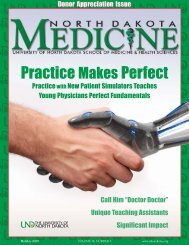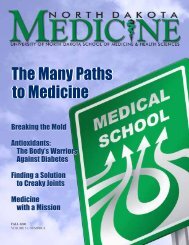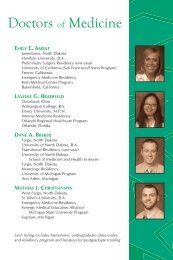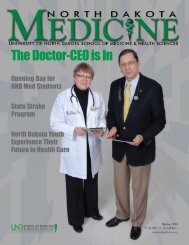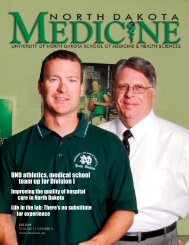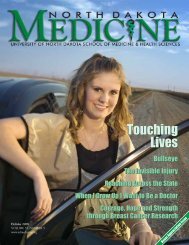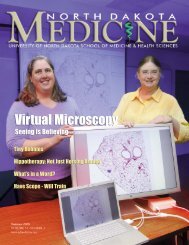View PDF - North Dakota Medicine
View PDF - North Dakota Medicine
View PDF - North Dakota Medicine
- No tags were found...
You also want an ePaper? Increase the reach of your titles
YUMPU automatically turns print PDFs into web optimized ePapers that Google loves.
By Juan PedrazaBuilding Better BrainsInaugural conference spotlights research strengths at the School.THE NATIONALLY RECOGNIZEDCenter of Biomedical ResearchExcellence (COBRE) neurosciencegroup at the University of <strong>North</strong> <strong>Dakota</strong>(UND) School of <strong>Medicine</strong> and HealthSciences recently hosted aneuroscience symposium titled“Building Better Brains.” It was the sixthsymposium organized by the groupsince receiving its initial grant in 2002from the National Center for ResearchResources, part of the NationalInstitutes of Health.“This symposium was an excellentopportunity for all of us to learn fromeach other with the expressed interestin discovering underlying causes of andpossible treatments for a number ofneurodegenerative disorders, includingAlzheimer’s disease, Parkinson’s disease,traumatic brain injury, and epilepsy,”said Dr. Jonathan Geiger, Chester FritzDistinguished Professor and chair of theDepartment of Pharmacology, Physiology,and Therapeutics, as well as interim chairof Anatomy and Cell Biology andprincipal investigator of the COBRE grant.The symposium highlighted workconducted at UND as well as theresearch of two highly regardedneuroscientists who discussed theirwork on Alzheimer’s disease, Down’ssyndrome, epilepsy, neural repair,Parkinson’s disease, schizophrenia,stroke, and stem cell therapeutics. Thesymposium also featured a specialpresentation by a noted UNDbiochemist, Dr. Roxanne Vaughan.Frank M. LaFerla, PhD, Chancellor’sProfessor of Neurobiology and Behavior,and director of the Institute for MemoryImpairments and Neurological Disorders(MIND) at the University of California–Irvine, has been at the forefront ofresearch into understanding Alzheimer’sdisease. His presentation was titled“Animal Models of Alzheimer’s Disease:Translational Successes and Challenges.”John R. Sladek, PhD, is a professorin the Department of Pediatrics andNeurology at the University of Colorado–Denver. He is a leader in neural repairand regeneration. Since 1974, he hasbeen studying neural repair mechanismsfor Parkinson’s disease and Down’ssyndrome. He spoke about “Stem CellTherapeutics for the Brain.”Roxanne Vaughan, PhD, is a professorin the UND SMHS Department ofBiochemistry and Molecular Biology.She focuses on explaining the workingsof the dopamine transporter, DAT,which regulates a lot of complex brainactivities. DAT is also a major site ofaction of psychostimulants such ascocaine and amphetamine.As part of this year’s symposium,Geiger delivered a presentation thatshowcased the enormous success of theCOBRE program at UND.“The data show how well we’vedone,” he said. “Since we started (withthe COBRE grant) in 2002, the numberof manuscripts that we’ve publishedhas gone up more than threefold, andit’s gone up that much again this year,and we’re not even through thecomplete year.”Geiger told the symposium thatthe COBRE system has had a majorimpact on the research portfolio atthe School.14 NORTH DAKOTA MEDICINE Holiday 2010



